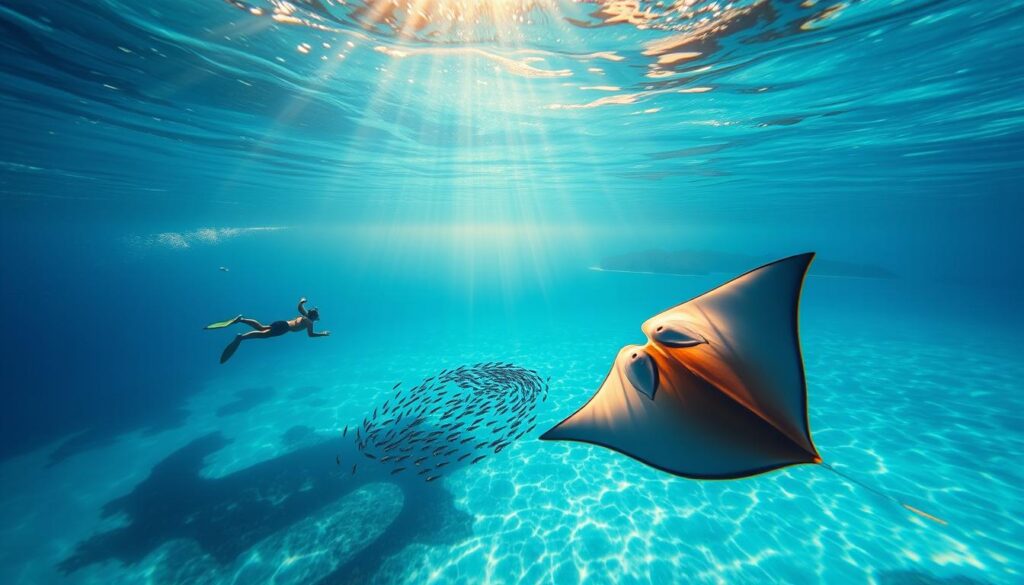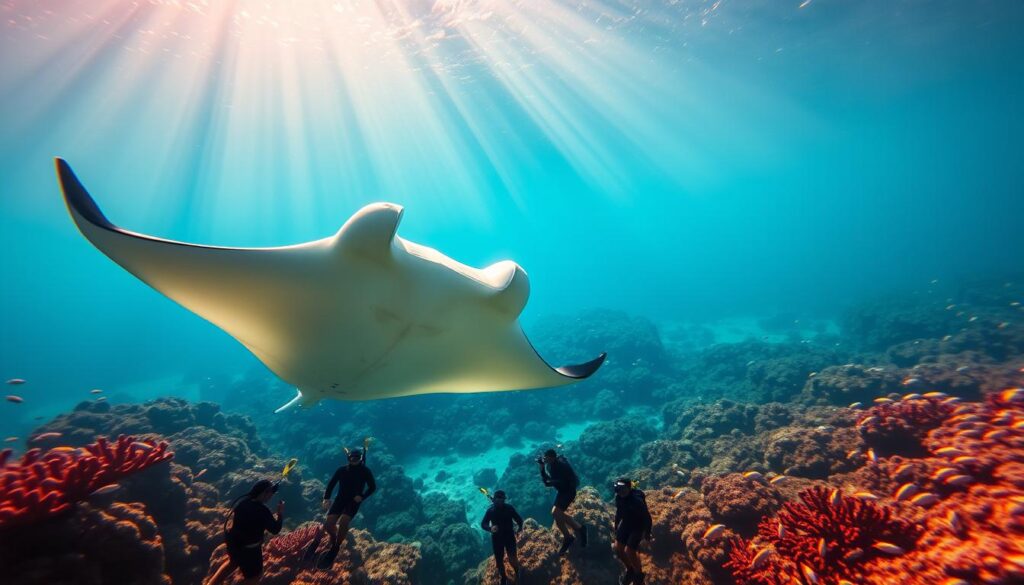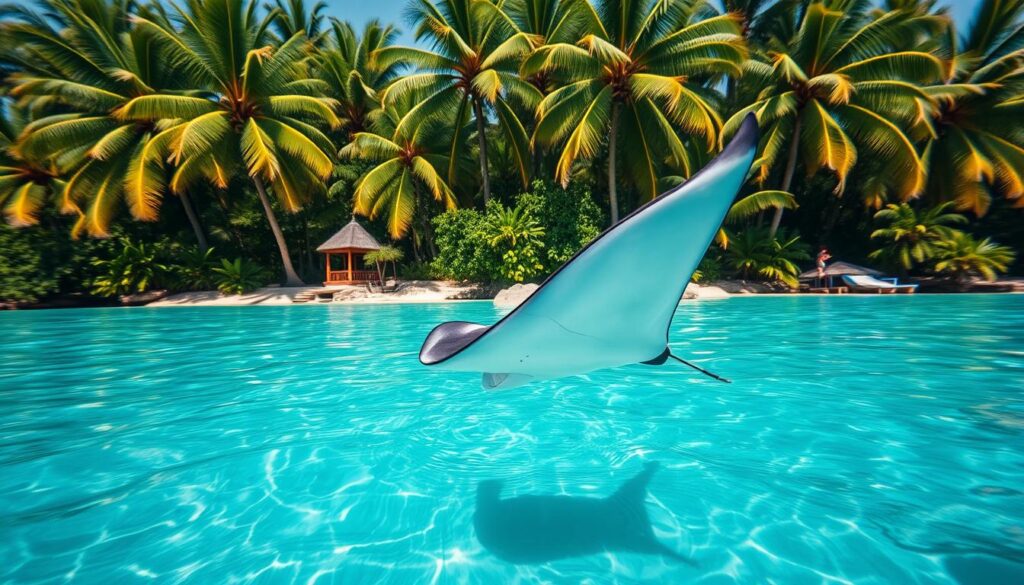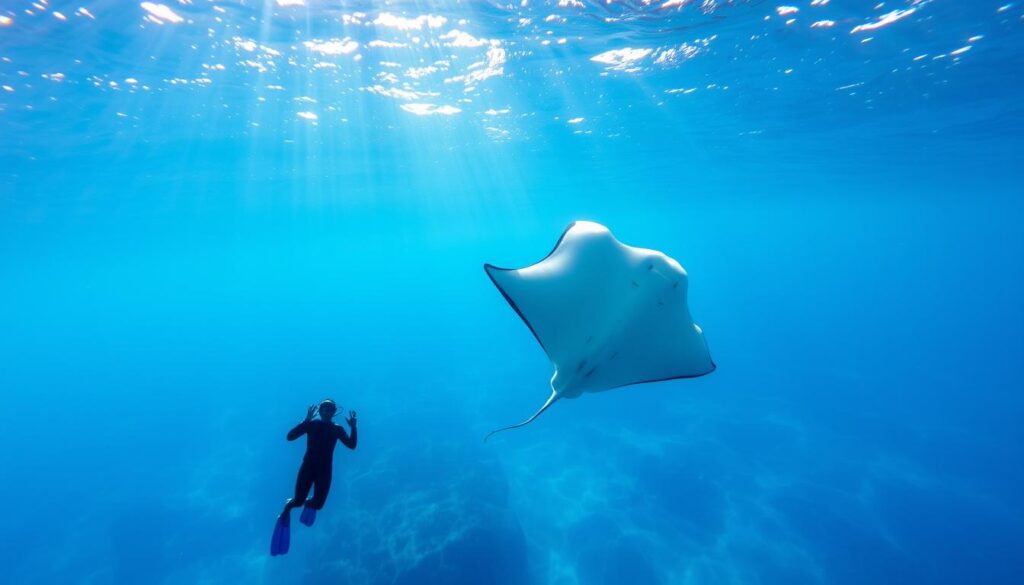Imagine swimming through clear waters, surrounded by manta rays. In the Cook Islands, this dream comes true. As you dive, you enter a world full of life, where these gentle giants swim right beside you.
The Cook Islands are a special place to meet manta rays in their home. It’s more than just swimming; it’s a deep dive into the ocean’s wonders. You’ll be amazed by the beauty and variety of marine life.
Key Takeaways
- Experience the magic of interacting with manta rays in the Cook Islands.
- Discover the rich marine life of the Cook Islands.
- Enjoy a unique and unforgettable manta ray swimming experience.
- The Cook Islands offer a pristine environment for manta ray encounters.
- Get ready for an adventure that will leave you with lifelong memories.
The Majestic Manta Rays of the Cook Islands
The waters of the Cook Islands are perfect for manta rays. They are a top spot for wildlife lovers. Here, you can see these amazing creatures up close.
Understanding Manta Ray Biology and Behavior
Manta rays are big and gentle. They eat a lot of plankton and small fish. Knowing how they act helps us appreciate them and protect them.
These rays are curious and often come near divers and snorkelers. This lets us learn about their behavior and biology. By studying them, we can find ways to keep them safe.
Why the Cook Islands Are a Manta Ray Haven
The Cook Islands have clear waters and lots of marine life. They also protect their environment well. This makes them a great place for manta rays.
Visitors can help by choosing tours that are good for the environment. This way, you’ll have a great time snorkeling with manta rays. You’ll also support the local community and conservation.
Best Locations for Swimming with Manta Rays in the Cook Islands: A Magical Encounter
Swimming with manta rays in the Cook Islands is magical. The ocean’s beauty shines in many amazing places. The Cook Islands have clear waters and lots of marine life, perfect for seeing these gentle giants.

Aitutaki Lagoon: Prime Manta Territory
Aitutaki Lagoon is a prime location for manta ray sightings. Its vast, shallow waters are full of marine life. This makes it a great place for mantas to feed on plankton and small fish.
Visitors can see mantas gliding through the water. Their big bodies move smoothly as they eat.
Rarotonga’s Western Coast
Rarotonga’s western coast is also great for manta ray sightings. The area’s rugged coastline and coral reefs attract mantas. Snorkelers and divers can see the rich marine life in these waters.
Other Notable Manta Ray Hotspots
There are other notable manta ray hotspots in the Cook Islands. Islands like Manuae and Palmerston offer unique chances to see mantas. These places are less crowded, giving a more private experience with the sea.
When you plan your trip to the Cook Islands, visit these spots. You’ll have a great chance to see mantas. The islands protect these amazing creatures, making them a top spot for manta ray enthusiasts.
Whether you dive or snorkel, the Cook Islands are a snorkeling and diving paradise. The clear waters and lots of marine life make every trip special.
When to Plan Your Manta Ray Adventure
To see majestic manta rays, knowing when to visit is key. The Cook Islands are great for swimming with these gentle giants all year. But some times are better than others for spotting them.
Peak Seasons for Manta Ray Sightings
The best time to see manta rays in the Cook Islands is from April to October. The waters are calm, and it’s perfect for manta ray feeding. April and May are the best months for seeing them.
Weather Considerations for Optimal Swimming Conditions
The weather in the Cook Islands affects your manta ray experience. The dry season, from April to November, is the best time. You’ll have clear skies and calm seas. But, be ready for tropical weather that can change the sea.
Plan your trip with the weather in mind for the best swimming. Visiting during peak season and watching the weather can make your manta ray adventure unforgettable.
Essential Preparation for Your Manta Ray Encounter
Getting ready for your manta ray swim tour in the Cook Islands is key. It’s not just about the excitement of swimming with these amazing creatures. You also need to prepare to stay safe and protect the mantas.

Required Swimming Skills and Fitness Level
To join a manta ray swim tour, you must be a strong swimmer. It’s not just about swimming. You need to be comfortable in the water and ready for snorkeling or diving for a long time.
- Be a confident swimmer, able to swim at least 200 meters without assistance.
- Have a reasonable level of fitness to handle the physical demands of snorkeling or diving.
- Familiarize yourself with snorkeling or diving gear if you plan to dive with mantas.
What to Pack for Your Manta Ray Swim
Bringing the right gear is vital for a fun and comfy Cook Islands wildlife encounter. Here’s what you should pack:
- Snorkeling or diving gear (mask, snorkel, fins, and wetsuit or rash guard).
- Sunscreen, a hat, and sunglasses for sun protection.
- Waterproof camera to capture your manta ray experience.
- Reusable water bottle to stay hydrated.
- Light, quick-drying clothing and a beach towel.
Health and Safety Preparations
Your health and safety are top priorities for a manta ray watching in the Pacific tour. Here are some important things to remember:
- Check with your doctor if you have any health concerns that might affect your ability to snorkel or dive.
- Understand and follow the safety briefings provided by your tour operator.
- Be aware of your surroundings and watch for any signs of distress from yourself or others.
By preparing well for your manta ray swim tour, you’ll have a better time. You’ll also help protect these incredible creatures and their home. The Cook Islands are a special place for a Cook Islands wildlife encounter. With the right preparation, you’ll be all set to enjoy it.
Choosing the Right Manta Ray Tour Operator
Your manta ray adventure in the Cook Islands begins with picking a responsible tour operator. This choice is key for a safe, fun, and eco-friendly trip.
Top-Rated Manta Ray Tour Companies
In the Cook Islands, some tour companies stand out in manta ray tourism. They focus on the safety and happiness of their guests and the sea.
- Company A: Known for their expert guides and commitment to sustainable tourism practices.
- Company B: Offers small group sizes to ensure a personalized experience and minimal environmental impact.
- Company C: Provides thorough safety briefings and gear for a secure encounter.
What to Look for in a Responsible Tour Provider
When picking a tour operator, look for these important factors for responsible tourism:
- Safety Record: Choose operators with a solid safety record and follow international standards.
- Environmental Commitment: Pick companies that support marine conservation and reduce their environmental impact.
- Guide Expertise: Make sure guides know a lot about manta rays and their home, sharing interesting facts during the tour.
- Group Size: Go for operators with small groups to lessen the impact on the sea and improve your experience.
By picking a reputable and responsible tour operator, you get a memorable trip. You also help protect the Cook Islands’ amazing marine life, like the Cook Islands manta rays.
When planning your best manta ray tour Cook Islands, the right operator will mix adventure with care for the planet. This makes your time with these gentle giants unforgettable.
Step-by-Step Guide to Swimming with Manta Rays
Going on a manta ray swim tour in the Cook Islands needs some prep for a magical and safe time. Knowing the steps will make your experience better and help protect these amazing creatures.
Pre-Swim Briefing and Safety Instructions
Before you dive in, a detailed briefing by your guide is key. It covers:
- Understanding safety steps and emergency plans
- Learning how to act around mantas responsibly
- Getting tips on where to snorkel or dive for the best views
Listening to these tips is vital for your safety and the mantas’ well-being.
Entering the Water and Positioning Yourself
When you get in the water, do it calmly to not scare the mantas. Your guide will show you the best spot to see them. Stay calm and quiet to get a close look without bothering them.
How to Observe Mantas Without Disturbing Them
Watching mantas without stressing them out takes patience and knowing their ways. Here’s how:
- Keep a safe distance to not touch or scare them
- Don’t use flash photos, as it can chase them away
- Let them come to you; it’s more natural and fun
By doing these things, you help with responsible and sustainable tourism that protects manta rays.
Exit Procedures and Post-Swim Activities
When it’s time to leave the water, do it slowly and calmly, following your guide. Afterward, many tours offer debriefing or sharing your adventure on social media. These extras make your trip better and help spread the word about manta ray care.
By following this guide, you ensure a memorable trip for yourself and help protect these incredible creatures and their home.
Manta Ray Encounter Etiquette and Conservation
The Cook Islands offer a unique chance to see manta rays in their natural home. By swimming with them responsibly, you help conservation efforts. It’s key to know how to swim with them and how tourism supports conservation.
Responsible Swimming Practices
When swimming with manta rays, it’s important to keep a safe distance. Keep a minimum distance of 3 feet to let them swim freely. Also, avoid touching or riding them, as it can harm them and change their behavior.
- Be mindful of your surroundings and avoid sudden movements that might startle the mantas.
- Never feed the mantas, as this can alter their feeding habits and make them dependent on humans.
- Follow the guidance of your tour operator and local guides, who are knowledgeable about the best practices for manta ray encounters.
By following these tips, your manta ray encounter can be both fun and sustainable.
How Your Visit Supports Manta Ray Conservation
Tourism is key in supporting manta ray conservation in the Cook Islands. By joining guided tours with reputable operators, you help the local economy. This also funds conservation efforts.
| Conservation Efforts | How Tourism Supports |
|---|---|
| Research and Monitoring | Tour operators often collaborate with researchers to study manta ray behavior, habitats, and populations, informing conservation strategies. |
| Marine Protected Areas | Revenue from tourism helps establish and maintain marine protected areas, providing a safe haven for manta rays and other marine life. |
| Community Engagement | Tourism initiatives often involve local communities in conservation efforts, promoting a culture of sustainability and environmental stewardship. |
As Dr. Jane Smith, a renowned marine biologist, notes, “Responsible tourism can be a powerful tool for manta ray conservation, supporting research, education, and community engagement.” By choosing eco-friendly tour operators and practicing responsible swimming habits, you can make a positive impact on manta ray conservation.
Your visit to the Cook Islands can be a meaningful way to support manta rays and their habitats. By being an informed and responsible tourist, you contribute to the long-term sustainability of these incredible creatures.
Budgeting for Your Manta Ray Experience
To have a stress-free manta ray adventure, budgeting is key. Knowing the costs helps plan a memorable trip in the Cook Islands.
Tour Costs and What’s Included
The main cost is the tour itself. Prices differ based on the operator, tour length, and what’s included. A guided manta ray tour in the Cook Islands can cost between $100 and $250 per person. These tours usually include:
- Guided tour by experienced professionals
- Equipment rental (snorkeling gear, wetsuits, etc.)
- Transportation to and from the tour location
- Safety briefing and instructions
Some tours might offer extra services like underwater photography or a free meal. This can make your experience even better.
Additional Expenses to Consider
While the tour covers a lot, other costs are part of your trip:
| Expense Category | Estimated Cost | Notes |
|---|---|---|
| Accommodation | $150-$300 per night | Costs vary based on hotel rating and location |
| Food and Beverages | $15-$30 per meal | Averages cost for a meal in the Cook Islands |
| Transportation | $50-$100 | Depends on whether you rent a car or use public transport |
| Marine Conservation Fees | $20-$50 | Some tour operators include this in their tour package |
Knowing these costs helps plan your manta ray experience better. Choose a reputable tour operator to make planning easier.

Effective budgeting for your manta ray adventure manages your expenses. It also improves your experience, letting you enjoy the encounter without worrying about costs.
Capturing the Perfect Manta Ray Memories
As you get ready to swim with manta rays in the Cook Islands, capturing the moment is key. With the right techniques and equipment, you can keep the memory of your encounter with these majestic creatures.
Underwater Photography Tips and Techniques
Underwater photography needs both technical skills and creativity. To get stunning manta ray photos, learn the basics of underwater photography. Start by getting comfortable with your camera equipment and practicing your shots before entering the water.
When taking photos of manta rays, keep a safe distance to avoid disturbing them. Use a camera with good autofocus and burst mode to capture the perfect shot. Consider using a strobe or external light source to make your images brighter and more detailed.
Recommended Camera Equipment for Marine Wildlife
Choosing the right camera equipment is key for high-quality manta ray photos. Look for a camera that is designed for underwater use, with waterproof housing and good low-light performance.
Popular choices include compact cameras with underwater housings, mirrorless cameras, and GoPro cameras. When picking a camera, think about image quality, ease of use, and durability.
- Compact cameras with underwater housings are a convenient and affordable choice.
- Mirrorless cameras offer better image quality and manual controls.
- GoPro cameras are great for wide-angle shots and are very durable.
By using the right techniques and camera equipment, you’ll be ready to capture memorable photos of your manta ray encounter in the Cook Islands.
Real Traveler Stories: Magical Moments with Cook Islands Mantas
In the crystal-clear waters of the Cook Islands, you can have a transformative encounter with gentle manta rays. It’s not just about seeing these magnificent creatures. It’s about connecting with nature on a deeper level.

Transformative Encounters and Personal Testimonials
Many travelers have shared their awe-inspiring stories of snorkeling with manta rays in the Cook Islands. For instance, Sarah, a marine biologist, recounted her experience:
“The moment I saw the mantas gliding through the water, I felt a sense of wonder I had never experienced before. It was as if I was swimming alongside giants of the ocean.”
Such encounters often leave a lasting impact. John, an avid snorkeler, described his experience as “a spiritual connection with the ocean and its inhabitants.” These testimonials highlight the profound effect that manta ray encounters can have on individuals.
What to Truly Expect: The Emotional Impact
When you embark on a manta ray watching tour in the Cook Islands, you can expect more than just a thrilling adventure. The experience is often described as life-changing, fostering a deeper appreciation for marine conservation.
| Aspect of Experience | Common Reactions |
|---|---|
| First Sighting | Awe, Excitement |
| Snorkeling with Mantas | Serenity, Wonder |
| Post-Experience | Reflection, Gratitude |
As you plan your Cook Islands adventures, remember that snorkeling with mantas is not just an activity. It’s an opportunity to create unforgettable memories and contribute to the conservation of these magnificent creatures.
Conclusion: The Unforgettable Magic of Swimming with Cook Islands Manta Rays
The Cook Islands are a top spot for a manta ray swim adventure. Their clear waters are filled with majestic manta rays. This makes your trip truly unforgettable.
Swimming with these gentle giants is awe-inspiring. It creates memories that last a lifetime. It’s more than just watching them; it’s about being part of their world.
Planning a trip here? The Cook Islands are more than a manta ray swim. They offer adventure, nature, and personal discovery. Whether you dive or just want a unique experience, the Cook Islands are perfect for your next adventure.
